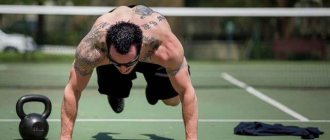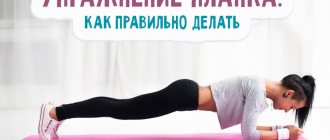The plank is one of the most popular exercises in fitness. It is often performed by athletes whose goal is to work out the abs with maximum efficiency, as well as strengthen the legs and back. The plank has several varieties. A very popular exercise is the side plank, which helps to increase the load on the abdominal and shoulder muscles, and simply diversify the workout.
Description of the exercise
The side plank, if done correctly, is very useful for both the figure and the body, and you can also do it at home. The benefits of the exercise are as follows:
- The exercise is performed in a static position, so it allows you to use a large number of muscle groups at once: abs, shoulders, back, legs.
- The side plank has earned special respect due to the fact that it effectively works the abs: during the execution, both the rectus and oblique abdominal muscles are tensed.
- Medical studies have found that exercise helps reduce back pain due to scoliosis and corrects posture. Doing the plank every day allows you to reduce pain by more than 30% within a few months of exercise.
- Another advantage of the strap is that it allows you to create a beautiful waist. In the process of performing it, the muscles contract isometrically, their strength develops and a kind of “tightening of the corset” occurs. Therefore, those who want to get rid of the “sides” at the waist should pay attention to this exercise.
Doing a side plank is useful for both beginners and professional athletes. It helps develop and strengthen muscles. The exercise is especially useful for the following categories of people:
- The side plank is useful for bodybuilders during the cutting period. Static tension helps to effectively remove excess deposits. For those who are just starting to play sports, the exercise will help strengthen the core muscles and prepare them for more serious loads.
- This exercise is recommended for those who suffer from scoliosis. The side plank is great for posture. It also helps relieve discomfort in the back and helps correct the curvature of the spine.
- For women, side planks help fight cellulite. Static tension will also allow you to quickly return to a beautiful figure after childbirth.
- Exercise is useful for leading a sedentary lifestyle . Take a break from working at the computer and spend a few minutes doing the plank. This will reduce the risk of a number of diseases associated with lack of activity.
The side plank is very popular in yoga. In it, it is known as Vasishtasana or sage pose.
When your lifestyle is sedentary
People suffering from scoliosis will find it very useful to perform this exercise. For those who have a job or generally a sedentary lifestyle, too.
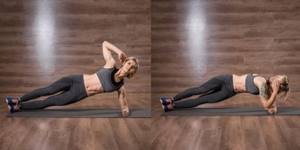
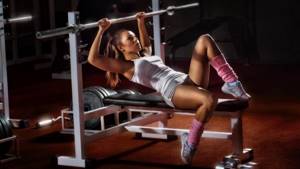
Exercises in the gym - tips for choosing the best set of exercises. Recommendations for beginners and tips on how to practice correctly (85 photos)
A set of exercises for gaining weight - basic exercises and recommendations for selecting weights for exercises

We perform squats with dumbbells - a description of the technique of performing the exercise. Subtleties and secrets of squats for girls (125 photos)
Taking a break from the monitor, getting up from the computer chair and stretching your body at least for a few seconds is already a relief for the spine and a shake-up for the muscles.

What muscles work during the side plank?
If you perform the side plank correctly, you can strengthen several muscle groups at once:
- By performing side planks alternately on your left and right arms, you can train your gluteus maximus, gluteus medius, calf muscles, and lateral thigh muscles. Over time, you can increase the load on these areas by performing more complex variations of the exercise with raising and holding the upper leg.
- The bar has a good effect on the cervical spine, upper shoulder girdle, and back extensors. Static tension will help not only strengthen the torso, but also reduce the risk of osteochondrosis of the neck and spine.
- The work also involves the abs, both rectus and oblique muscles. To work the abdominal muscles more effectively, it is recommended to additionally retract the stomach when performing the exercise.
- The arms (biceps and triceps) , which need to hold half of the entire body, are also worked out during the execution
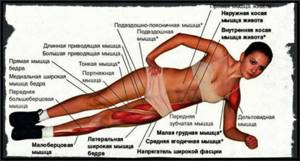
To achieve a harmonious workout of the entire body, perform the side plank alternately on both sides for the same amount of time.
Mirror to the rescue
If you make a mistake, there will be no effect. If you round your back, it will quickly hurt; lowering your head means wasting your neck muscles; Don’t strain your buttocks – your pelvis will sag.
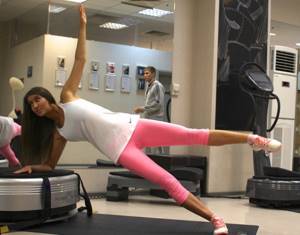
The wrong elbow position is fraught with injury. Therefore, until the body gets used to it, it is better to position yourself in front of some mirror surface and control the process with your own eyes.
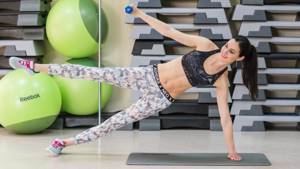
Execution technique
Let's figure out how to do a side plank correctly. The exercise itself is not difficult, but it is important to master the correct body position and load distribution - this way you can get maximum results.
The side plank technique involves the following sequence of actions:
- First, prepare a suitable place to perform the exercise. It is better to lay a special rug on the floor.
- Lie on your side. Place your elbow on the floor and lean on it so that you are comfortable and your forearm completely touches the floor.
- Lift your hips off the mat.
- Keep your torso straight. Your body should be like a stretched string.
- Lock yourself in this position and stay in it as long as you can.
- Then rest and repeat the same on the other side.
Having mastered how to do the classic side plank on the elbow, you can move on to more complex variations.
As a bonus
This exercise strengthens not only muscles, but also character, developing perseverance and endurance and instilling self-confidence. And the longer the stand time becomes, the more expressively all this manifests itself.

On the first day, 15 seconds will be enough, on the second, it is advisable to stand for 20 seconds, on the third, add another 5 seconds to this number, etc. If you do not violate the side plank technique, then the result will already be from training three times a week.

Varieties
Let's look at other, more complex variations of the side plank.
Arm's length plank
This exercise is more effective than the previous one, but it is more difficult, so move on to it after you have mastered the elbow plank.
Let's look at how to learn how to do a side plank in this variation.
- Lower yourself to your side on the floor. Keep your legs together. The emphasis should be placed on the straight, outstretched arm located below. The hand should be positioned clearly under the shoulder.
- Hold your breath, lift your hips off the floor, placing emphasis on the foot located closer to the floor, and draw in your stomach.
- Stay in this position for a few minutes. Then take a break and switch sides.

Side plank with crossed legs
Having mastered the previous exercises, you can make the side plank more difficult by performing it as follows:
- You need to lie on your side on the floor. Rest on your elbow or straight leg.
- Cross your feet so that the top one is in front of the bottom one.
- Holding your breath, lift your hips off the floor and pull in your stomach.
- Stay in this position for a few seconds and change sides.

Advanced side plank
An even more difficult version of this exercise is the side plank. Its implementation involves the following actions:
- Lower yourself to your side on the floor. Focus on your straight arm. The hand should be positioned clearly under the shoulder.
- Raise your top arm so it is perpendicular to the floor.
- Lift your hips off the floor, placing emphasis on the foot of your lower leg, lift your upper leg as high as possible and draw in your stomach.
- Stay in this position for a few seconds. Then take a short break and change sides.
How long should you hold the bar? As much as you can. If you are a beginner, at least 20-30 seconds will be enough, increase this time over time.

Contraindications and precautions
Despite all the benefits of the exercise, it has contraindications that need to be taken into account. It is not recommended to perform the exercise in the following cases:
- in the presence of an intervertebral hernia;
- for injuries to the back, shoulders, neck;
- late pregnant women;
- regular severe pain in the back (you need to consult a specialist).
Also, in how to do the side plank exercise correctly, you need to avoid common mistakes and shortcomings that can provoke not only a deterioration in results, but also risks for the body. Among them the following stand out:
- Rounding the back. To avoid this mistake, work your back muscles.
- Incorrect position of the head, pelvis and arms. This mistake is often made by beginners due to lack of preparation. To avoid this, first master a regular plank, using your knees as additional support.
- Bend your knees. It is very important to ensure that the body is in a straight line.
- If, in a static position, you do not particularly feel tension in the abdominal area, this indicates that the exercise is being done incorrectly, so it is important to hone its technique.
To improve your results, follow these recommendations:
- Before fixing the pose, tighten your abs and gluteal area.
- Look forward, keep your neck straight so that it is tense.
- To control the correctness of the technique, at first you can perform the exercise in front of a mirror.
- Try to keep your body static for as long as possible.
- To properly load the target muscle group, do at least 3-4 repetitions.
Retention is not an easy task
To hold your own body up, you need to force an impressive number of muscles to work simultaneously and to the maximum. At the same time, they will have to remain tense for a long time (unlike active training, where tension is quickly replaced by relaxation). By the way, trembling in the arms, legs or in the abdominal area is a sure sign that the muscles are working.








